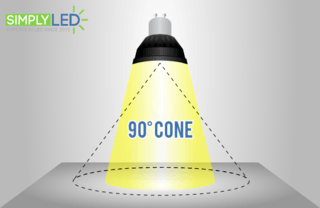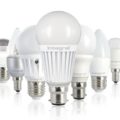Before we consider exactly what constitutes a useful lumen, it’s worth considering the two different kinds of light beam, and the effect which you wish to achieve by using either of them.
If a lamp features a beam angle which is wider than 90 degrees, it’s classed as wide angle as opposed to directional, and is therefore unsuitable for accented lighting like spotlights. Conversely, a beam of less than 90 degrees is considered directional and can be used for dramatic lighting in and around the home.
Although lumens are the measurement of visible light for either wide angle or directional beams, understanding useful lumens is particularly essential for the selection of an efficient directional light.
Due to the fact that you require accented lighting, the total number of lumens does not provide an accurate representation of the illumination which the lamp offers – as light can disperse, reducing the “spotlight” effect of the light. Useful lumens, represented by the symbol , are a unit of measurement for the amount of visible light within a 90 degree radius in any given direction. This can be essential information when choosing a lamp for dramatic lighting or a spotlight effect, as you’ll gain a more useful insight into the actual illuminating effect which the lamp will have on your room.
Not only will this information help you to choose the best individual product for your room, it’ll also allow you to compare different types of bulb. If you’re considering an investment into inexpensive and efficient LED lighting, you’ll also be able to quickly and easily compare the amount of bulbs required for illumination equal to any halogen or compact fluorescent light bulb.
For example, you may want to consider the GU5.3 and MR16 low voltage LED light bulbs sold here at SimplyLED. For the equivalent of a 20w halogen light bulb, look for over products boasting over 180 useful lumens. The same goes for 300 useful lumens for a 35w bulb, and 540 useful lumens for a 50w halogen bulb. If you’re seeking mains voltage LED lighting like the GU10, Par16 or Par20, you should look for 200 useful lumens for the equivalent of a 35 watt halogen bulb, or 300 useful lumens for a 50w halogen bulb.
What you should look for?
For low voltage lighting MR16 or GU5.3, the LED equivalent to Halogen reflector bulbs is:
more than 180 useful lumens for the equivalent to a 20 watt halogen reflector bulb
more than 300 useful lumens for the equivalent to a 35 watt halogen reflector bulb
more than 540 useful lumens for the equivalent to a 50 watt halogen reflector bulb
For mains voltage lighting GU10 or Par16 or PAR20, the LED equivalent to Halogen reflector bulbs is:
more than 200 useful lumens for the equivalent to a 35 watt halogen reflector bulb
more than 300 useful lumens for the equivalent to a 50 watt halogen reflector bulb
With these figures in mind, you’re able to quickly and easily determine the most appropriate product for your individual needs, making the switch from expensive halogen lights to cost-effective LED lighting easier than ever before. You can maintain the same level of illumination, while saving money on bulb replacements and your electricity bill.
If you would like to discuss the most appropriate LED light for installation in your home, or you have a question about one of our products, please get in touch via our contact page.




